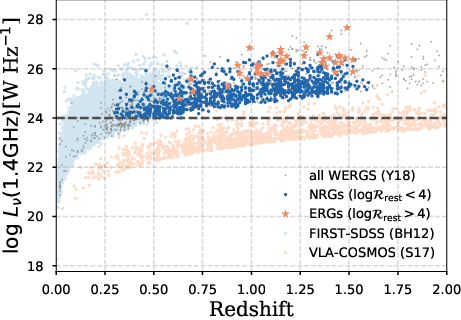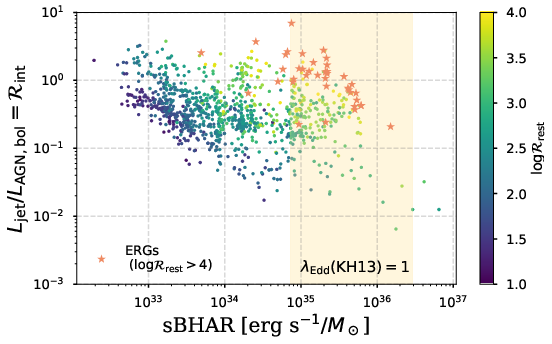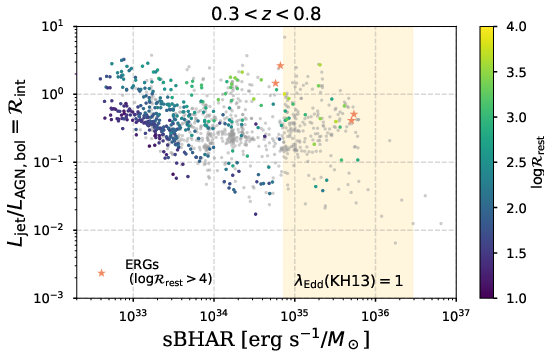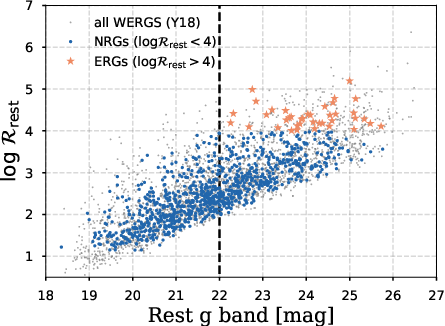研究成果・発表論文
A Wide and Deep Exploration of Radio Galaxies with Subaru HSC (WERGS). IV. Rapidly Growing (Super)Massive Black Holes in Extremely Radio-loud Galaxies
Ichikawa, Kohei, Yamashita, Takuji, Toba, Yoshiki, Nagao, Tohru, Inayoshi, Kohei, Charisi, Maria, He, Wanqiu, Wagner, Alexander Y., Akiyama, Masayuki, Vijarnwannaluk, Bovornpratch, Chen, Xiaoyang, Kajisawa, Masaru, Kawamuro, Taiki, Lee, Chien-Hsiu, Matsuoka, Yoshiki, Schramm, Malte, Suh, Hyewon, Tanaka, Masayuki, Uchiyama, Hisakazu, Ueda, Yoshihiro, Pflugradt, Janek, & Fukuchi, Hikaru
要旨
We present the optical and infrared properties of 39 extremely radio- loud galaxies discovered by cross-matching the Subaru/Hyper Suprime-Cam (HSC) deep optical imaging survey and VLA/FIRST 1.4 GHz radio survey. The recent Subaru/HSC strategic survey revealed optically faint radio galaxies (RG) down to gAB ~26, opening a new parameter space of extremely radio-loud galaxies (ERGs) with radio- loudness parameter of log rest = log(f1.4GHz,rest∕fg,rest)4. Because of their optical faintness and small number density of ~1 deg-2, such ERGs were difficult to find in the previous wide but shallow or deep but small area optical surveys. ERGs show intriguing properties that are different from the conventional RGs: (1) most ERGs reside above or on the star-forming main- sequence and some of them might be low-mass galaxies with log(M⋆∕M⊙)10 . (2) ERGs exhibit a high specific black hole accretion rate, reaching the order of the Eddington limit. The intrinsic radio loudness (
rest = log(f1.4GHz,rest∕fg,rest)4. Because of their optical faintness and small number density of ~1 deg-2, such ERGs were difficult to find in the previous wide but shallow or deep but small area optical surveys. ERGs show intriguing properties that are different from the conventional RGs: (1) most ERGs reside above or on the star-forming main- sequence and some of them might be low-mass galaxies with log(M⋆∕M⊙)10 . (2) ERGs exhibit a high specific black hole accretion rate, reaching the order of the Eddington limit. The intrinsic radio loudness (  int ), defined by the ratio of jet power over bolometric radiation luminosity, is one order of magnitude higher than that of radio quasars. This suggests that ERGs harbor a unique type of active galactic nuclei (AGN) that show both powerful radiations and jets. Therefore, ERGs are prominent candidates of very rapidly growing black holes reaching Eddington-limited accretion just before the onset of intensive AGN feedback.
int ), defined by the ratio of jet power over bolometric radiation luminosity, is one order of magnitude higher than that of radio quasars. This suggests that ERGs harbor a unique type of active galactic nuclei (AGN) that show both powerful radiations and jets. Therefore, ERGs are prominent candidates of very rapidly growing black holes reaching Eddington-limited accretion just before the onset of intensive AGN feedback.








 Ja En
Ja En